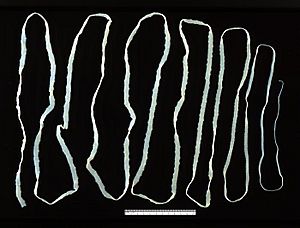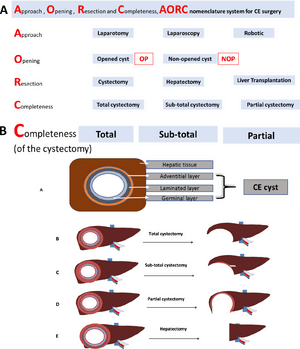Eucestoda facts for kids
Quick facts for kids Eucestoda |
|
|---|---|
 |
|
| Taenia saginata adult | |
| Scientific classification |
|
| Kingdom: | Animalia |
| Phylum: | Platyhelminthes |
| Class: | Cestoda |
| Subclass: | Eucestoda |
Eucestoda, also known as tapeworms, are a type of flatworm. They are part of a larger group called Cestoda. Unlike some other flatworms, tapeworm larvae have six hooks on their head, called a scolex. All tapeworms are parasites that live inside the bodies of animals with backbones (like humans, dogs, or fish). They usually live in the digestive system. For example, the pork tapeworm lives in humans as its main host, and pigs are its secondary host.
Contents
Tapeworm Body Structure
Adult tapeworms are usually white and flat. They can be very long, from a few millimeters to up to 25 meters! Most tapeworms are made of many repeating parts called proglottids. Each proglottid has its own set of reproductive organs.
The tapeworm's body has three main parts:
- The scolex (head): This is a small part at the front, usually less than 1 millimeter. It has special tools like suckers, grooves, or hooks to help the tapeworm stick to the inside of its host.
- The neck: This small area is right behind the scolex. It's where new proglottids are constantly made.
- The strobila: This is the longest part of the tapeworm's body. It's a chain of many proglottids that become more mature as they get further from the neck.
Tapeworms don't have a mouth or a digestive system. Instead, they soak up all their food directly through their skin! They have tiny, hair-like structures called microtriches on their body surface that help them absorb nutrients. Tapeworms also have a simple system for getting rid of waste and a "ladder-like" nervous system that runs along their body.
Tapeworm Reproduction
Tapeworms reproduce by making eggs. Each proglottid in the strobila has male and female reproductive organs. These organs develop over time. First, the male parts mature, and then the female parts. As you move down the tapeworm's body, you'll find proglottids with mature male organs, then proglottids with mature female organs, and finally, proglottids full of fertilized eggs. These egg-filled proglottids are called "gravid."
Tapeworm Life Cycle
A tapeworm can live for a short time, like a few days, or for a very long time, even over 20 years! Tapeworms go through different stages in their lives, often needing different hosts to complete their journey.
It all starts with a tiny embryo that has six hooks. This embryo is called an oncosphere. To grow, this embryo needs to be eaten by a first intermediate host. This host is usually an insect or another small creature.
After the first host eats the embryo, the tapeworm larva develops further. For most tapeworms, a second intermediate host is needed. This second host is often a fish, but it can be another animal. When the scolex (head) of the larva is fully formed, it stops growing until a vertebrate (like a human or a dog) eats the infected intermediate host. Once inside the final host, the tapeworm grows its long body (the strobila) and becomes an adult. Many tapeworm species are very picky and can only live in one specific type of final host.
Common Tapeworm Species
Here are some common tapeworm species and the animals they can infect:
| Final Host | Species |
|---|---|
| Humans | Diphyllobothrium latum, Spirometra erinacea euopaei, Taenia solium, T. saginata, T. asiatica, Rodentoleptis nana, Hymenoleptis diminuta |
| Cats | Diphyllobothrium latum, Spirometra erinacea euopaei, T. pisiformis, Echinococcus multilocularis, Dipylidium caninum |
| Dogs | Diphyllobothrium latum, Spirometra erinacea euopaei, T. hydatigena, T. ovis, T. pisiformis, T. multiceps, T. serialis, E. granulosus, E. multilocaris, Dipylidium caninum |
| Fish | Caryophyllaeus laticeps, Glaridacris catostomi, Archigetes sieboldi, Triaenophorus sp., Eubothrium sp., Rhinobothrium sp., Phyllobothrium sp., Proteocephalus ambloplites |
| Fish-Eating Birds | Ligula intestinalis, Schistocephalus solidus |
| Rodents | Schistocephalus solidus, Rodentoleptis nana, Hymenolepis diminuta |
| Horses | Anoplocephala magna, Anoplocephala perfoliata |
| Ruminants | Moniezia expans, Avitellina sp., Thysaniezia sp., Stilesia sp. |
| Chickens | Davainea proglottina, Raillietina tetragona, Amoebotaenia sp., Choanataenia sp., Hymenolepis carioca |
| Foxes | T. ovis, T. multiceps, T. serialis, E. granulosus, E. multilocularis, Mesocestoides leptothylacus, Dipylidium caninum |
| Lagomorphs | Cittotaenia sp. |
Tapeworms and Your Health
Tapeworms can cause different health problems depending on the type of worm and where it lives in the body.
Taeniasis: Intestinal Tapeworm Infection
Taeniasis is an infection that happens when adult tapeworms from the Taenia group live in your intestines. You can get it by eating raw or undercooked beef or pork that has tapeworm larvae in it. Most people have no symptoms or only mild ones, like weight loss or a stomach ache. Sometimes, you might see small segments of the tapeworm in your poop.
Cysticercosis: When Larvae Travel
Cysticercosis is a tissue infection caused by the young form of the pork tapeworm. This happens if you swallow tapeworm eggs. The eggs hatch in your stomach, and the tiny larvae then travel through your blood to different parts of your body, like your brain, eyes, or muscles. In these places, the larvae form small sacs called cysts. When these cysts die, they can cause inflammation and serious problems, especially if they are in the brain (called neurocysticercosis).
Echinococcosis: Hydatid Disease
Humans can accidentally get worms from the Echinococcus group. This causes a disease called echinococcosis, or hydatid disease. Children often get it by touching infected dogs or eating food that has dog poop on it. The eggs hatch in your stomach, and the larvae travel to organs like the liver or lungs, where they form large cysts. These cysts can grow and cause problems, but often people don't have symptoms for a long time.
Hymenolepiasis: The Dwarf Tapeworm
Hymenolepiasis is caused by the "dwarf tapeworm," Hymenoleptis nana. You can get it by eating infected insects, drinking water with eggs in it, or from dirty hands. This is a very common intestinal worm. If you have a lot of worms, it can cause stomach problems and allergic reactions like skin rashes.
Diphyllobothriasis: The Fish Tapeworm
Diphyllobothriasis is caused by the "broad tapeworm" or "fish tapeworm," Diphyllobothrium latum. People get this by eating raw, undercooked, or marinated fish that contains the worm larvae. This tapeworm can grow very long, sometimes over 15 meters! A common problem it causes is vitamin B12 deficiency, which can lead to anemia, because the worm absorbs a lot of the vitamin.
Sparganosis: Spirometra Larvae
Sparganosis is caused by the larvae of the Spirometra tapeworm. You can get it by drinking contaminated water, eating raw or undercooked infected meat (like pork or snake), or even by putting raw infected meat on your skin as a traditional medicine. The most common symptom is a painful lump under the skin that slowly grows. If the infection is in the eye, it can cause pain, swelling, and even blindness. In rare cases, it can affect the brain.


